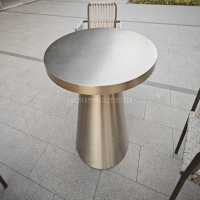Welcome to the website for landscape facilities products and knowledge.
How does the table’s design address concerns about surface hardness for dining comfort?
The quest for the perfect dining table often centers on a crucial, yet frequently overlooked, characteristic: surface hardness. A table that is too soft is prone to scratches, dents, and stains, causing constant worry and diminishing its longevity. Conversely, a surface that is perceived as excessively hard can feel cold, uninviting, and noisy, disrupting the comfort of a meal. Modern table design ingeniously addresses this paradox through a multi-faceted approach, ensuring the surface is durable enough for daily use while remaining comfortable for dining.
The primary strategy lies in the intelligent selection and engineering of materials. Designers are moving beyond traditional, purely hard options. For instance, solid wood tables are often finished with advanced, penetrating oils or ultra-durable ceramic coatings. These treatments seep into the wood fibers, creating a shield that resists scratches and moisture, thereby increasing the effective surface hardness for protection. However, the underlying wood retains a slight natural give, preventing the harsh, clattering feel of stone or glass. Similarly, engineered composites and high-pressure laminates are manufactured to mimic the visual appeal of natural materials while incorporating a resilient core that absorbs minor impacts, reducing the likelihood of permanent damage from cutlery or plates.
Furthermore, the construction method itself plays a pivotal role. Tables with a robust underframe and adequate support prevent flexing and movement, which can cause micro-stresses on the surface over time. A stable foundation ensures that the hardness of the tabletop is not compromised by a wobbly structure. Additionally, the edge profile is a critical design element. A softly rounded or bevelled edge feels gentler against a diner's arms compared to a sharp, 90-degree corner, psychologically enhancing the perception of comfort even on a hard surface.
Finally, the incorporation of table accessories is a clever design solution. The use of tablecloths, placemats, and coasters is no longer just decorative; it is a recommended part of the table's ecosystem. Designers now create tables with surfaces that work in harmony with these accessories. A moderately hard surface provides a smooth, stable base for a placemat, preventing slippage and ensuring an optimal dining experience. This allows homeowners to enjoy the aesthetic of a beautiful, durable tabletop while personalizing the tactile comfort for each meal. In conclusion, through material science, thoughtful construction, and integrated accessory use, contemporary table design successfully navigates the challenge of surface hardness, delivering furniture that is both resilient for practicality and comfortable for daily enjoyment.
Related search:

Recommendation
Outdoor Metal Table - Classic Outdoor Furniture, Stainless Steel Table, Durable and Reliable